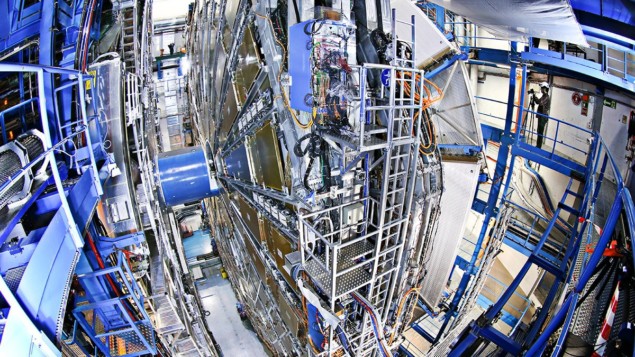
For the first time, particle physicists have observed the simultaneous production of a photon and a top quark. The milestone was achieved by the ATLAS collaboration, which operates a giant detector at CERN’s Large Hadron Collider (LHC). The discovery could lead to a deeper understanding of the electroweak interaction, and its enigmatic relationship with the Higgs field.
According to the Standard Model of particle physics, the Higgs field provides mass to some fundamental particles via electroweak symmetry breaking (a process called the Higgs mechanism). This idea was first proposed in 1964 and confirmed in 2012, when physicists working on ATLAS and CMS (also at the LHC) made the first observation of the Higgs boson – which is the particle manifestation of the Higgs field.
However, more than decade after that famous discovery, the inner workings of this symmetry-breaking mechanism have remained a stubborn mystery. And much effort is being made at the LHC to solve this mystery.
In this latest study, ATLAS researchers delved deeper into electroweak symmetry-breaking by examining detections of the top quark in data gathered by the experiment during the collisions of high-energy protons. The top quark is especially well-suited to the task as it interacts with the Higgs field more strongly than any other fundamental particle, making it the heaviest particle in the Standard Model.
Easier said than done
Ideally, this study would involve studying the decay products of individual top quarks – looking for deviations from predictions of the Standard Model that could shed light on electroweak symmetry-breaking. But this is easier said than done, according to John Alison at Carnegie Mellon University in the US – who belongs to the CMS collaboration and is a former member of ATLAS.
“Single top quark production is hard to see, as it is produced by the weak interaction. This makes it far smaller than top-quark pair production, which is controlled by the strong interaction.”
However, these quark–antiquark pairs are far less sensitive to the electroweak interaction and do not tell us about origins of symmetry breaking nearly as effectively as single top quarks.
To work around this issue, the team searched for evidence of an alternative pair of particles in ATLAS’ data. “This analysis takes single quark observations one step further,” Alison explains. “The ATLAS team tried to observe a single-top with an extra photon interacting with the top quark, whose charge is directly related to the size of the signal.”
Plethora of pairs
These single top quarks exist within a plethora of quark–antiquark pairs, and to find them the researchers looked for simultaneous detections of the top quark’s specific set of decay products.
Following its production, a top quark quickly decays into a bottom quark and a W boson, which itself decays either into either an electron or muon, and a neutrino. Simultaneously, the bottom quark combines with other quarks to form new hadrons. These particles then decay into a collimated spray of particles called a “b jet”.
Detecting these specific products presented a further challenge. Looking for a top quark–photon pair is hard enough, but the ATLAS team went beyond, using machine-learning techniques to directly probe the top–photon coupling,” Alison explains.
Trained using simulations of top quark–photon events, the team’s machine-learning algorithm could specifically pick out simultaneous detections of the gamma-ray photon, b jet, electron or muon, and some missing energy associated with the neutrino – which passes invisibly through ATLAS’ detectors.
High degree of confidence
Their results were incredibly promising. “The process was observed with a high degree of confidence, far beyond the 5σ confidence level that is the benchmark in the field,” Alison says. Altogether, the top quark–photon observations identified by the algorithm had a statistical significance of 9.8σ. This means it is extremely improbable that the events could have emerged randomly.

High-precision measurement of the strong force is made at CERN
What’s more, “The number of signal events observed roughly agrees with that predicted by our theory,” Alison continues. This detection rate was some 30–40% higher than that predicted by the Standard Model.
The ATLAS team now hopes to probe the properties of top quark–photon events in more detail in future studies – with the aim of uncovering new clues about the inner workings of electroweak symmetry breaking. If achieved, this could be a key step towards understanding the mass-giving nature of the Higgs boson.
“The result could be used to constrain hypothetical theories that are deeper than the Standard Model,” Alison adds. “Observing this process also offers a new way to test the predictions of the Standard Model, and demonstrates how we can tease out a small, complex signal from much larger backgrounds.”
The research is described in Physical Review Letters.
- SEO Powered Content & PR Distribution. Get Amplified Today.
- PlatoData.Network Vertical Generative Ai. Empower Yourself. Access Here.
- PlatoAiStream. Web3 Intelligence. Knowledge Amplified. Access Here.
- PlatoESG. Carbon, CleanTech, Energy, Environment, Solar, Waste Management. Access Here.
- PlatoHealth. Biotech and Clinical Trials Intelligence. Access Here.
- Source: https://physicsworld.com/a/simultaneous-production-of-a-top-quark-and-a-photon-observed-for-the-first-time/



